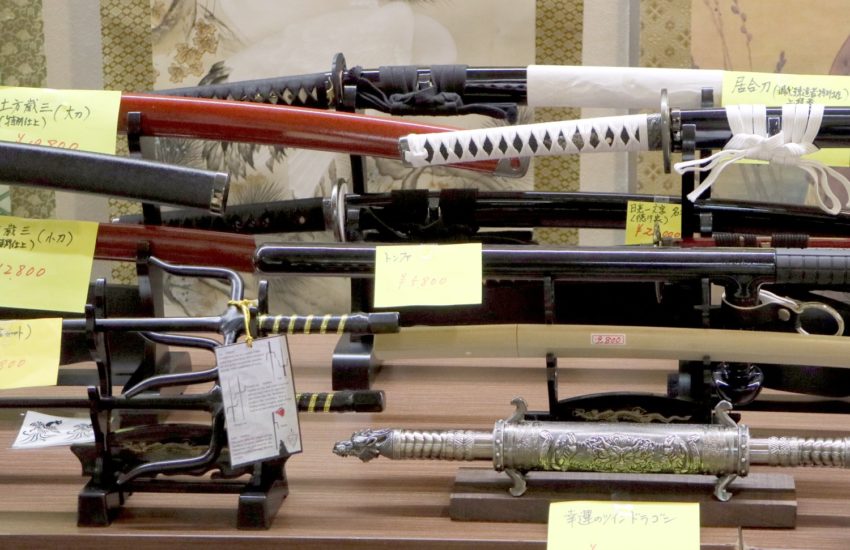Many of us would love to own an original Masamune katana but the best we can hope for is to observe one within a museum under protective glass and a security detail. This is where modern forged swords come into play. You may not be able to have an authentic blade used during an event like the Genpei War, but you can certainly find an authentic period replica. This article is all about the market for modern Japanese swords that your average sword collector is likely to frequent.
“Everything Changed After Imperial Japan Attacked”
The end of World War II marked the point where swordsmithing transitioned into what collectors and historians regard as the era of modern Japanese swords. The victorious military of the United States of America had forced Japan’s armed forces to disband, and the Americans also limited edged swords from being owned by civilians. Only the police or people given special dispensation to wield a blade by permission of the government were allowed.
“So how is it that someone can still produce modern Japanese swords?” you may ask. This change in policy lays squarely at the feet of one Dr. Junju Honma. Honma was granted a meeting with Gen. Douglas MacArthur in order to appeal to his sense of cultural respect. Honma used his meeting to showcase a variety of nihontoNIHONTO 日本刀 "Japanese sword" learn more... from various eras, giving the general a chance to see that some weapons were beautiful enough to merit preservation and were forged with such craftsmanship that they were elevated into the status of precious cultural treasures.
Honma’s actions resulted in an amendment to the sword ban, calling for the protection of any sword deemed worthy of artistic merit. Despite this clause, many Americans were able to purchase gorgeous nihonto at bargain bin prices. By 1958, more Japanese swords could be found within the United States than in all of the prefectures of Japan. While the bulk of the swords acquired by the Americans were guntoGUNTO 軍刀 "(modern) saber" learn more..., straight-edged late-era military swords, some of them were considerably older.
“Alright, but what about Japanese swords forged after World War II?”
The overarching term for modern Japanese swords made from 1953 onward, is shinsakuto, meaning simply “newly-made swords.” The most frequently encountered design of shinsakuto would be the “Shinogi-Zukuri” katanaKATANA 刀 "sword" learn more..., a curved, single-edged longsword common to samurai. While the Shinogi-Zukuri style is the most common design for modern blades, it is not unheard of to encounter a double-edged tsurugi; long, single-edged tachiTACHI 太刀 "great sword" learn more...; wakizashi short swords or tanto knives. While the naginata and yariYARI 槍 "spear or lance" learn more... are varieties of polearms, they still obey all the normal laws and restrictions involved in modern sword forging.
“Who makes modern Japanese swords today and where can I buy one?”
Some of the smiths who survived World War II were able to continue their craft, including Dr. Honma. Honma, in fact, would go on to found the “Nippon Bijutsu Token Hozon Kyokai” (NBTHK), a society dedicated to preserving Japan’s unique swords. The NBTHK was established with the goal of keeping the old smithing and forging techniques in circulation and to preserve Japanese swords. It is thanks to groups like them that Japanese swordsmithing exists to this day.
Enter Akitsugu Amata
One smith, Akitsugu Amata, is one of the few notable Japanese sword makers to continue his trade into the 21st entury; he died in 2013. Amata continued his family’s business after his father passed in 1937, relocating to Tokyo and enrolling in Nihonto Tanren Denshu Jo, a prestigious sword-making school run by Kurihara Hikosaburo. Amata apprenticed under Kurihara for six years before returning home, finding that the natural mixture of water and clay lent itself well to the hardening step of making a sword. He also smelted tamahaganeTAMAHAGANE 玉鋼 "jewel steel" learn more... in his own home.
After the sword ban was partly removed, Amata received his license in 1954, the same year he would win a prize in Japan’s first national competition for sword-forging. Despite suffering from an illness for eight years, Amata’s recovery at the age of 41 seemed to only heighten his skills: he received the top honor of the Masamune Prize at a “New Katana Sword Exhibition” in 1968.
Amata would continue to win awards in competitions in 1977, 1985, and 1996. Ultimately, 1997 would see him gain recognition as a Living National Treasure. Amata was both the Chairman of All Japan Swordsmith’s Association and director of the NBTHK.
“Yeah, yeah, that’s real cool and interesting and all, but where can I buy modern Japanese swords?”
There are a number of locations you might consider visiting when you decide to purchase a modern nihonto.
- Rennaisance fairs
- The Internet
- A swordsmithing shop
- Estate sales
- Yard sales
- Festivals dedicated to Japanese culture
- Anime conventions
- Martial arts conventions
- Gun shows
If you are looking to invest some serious coin in the genuine article, a proper Japanese-made katana, know that the process is very similar to commissioning a work of art. This extends into an understandable amount of red tape as it must be clear that you are interesting in buying a piece of artwork, and not a lethal weapon nor something that could even be realistically used to pass for a lethal weapon.
Commissioning a blade from a Japanese smith requires you obtain the relevant documents and certification in order to secure ownership, plus the obvious costs of shipping the blade or traveling to Japan in order to pick it up in person. Japanese smiths require licenses to make a sword and earning that license requires a lengthy amount of time spent as an apprentice to a licensed master.
While you might consider dealing with an independent smith outside of the Japanese state, know that the quality of such a blade tends to fluctuate based on the individual merchant. The sole non-Japanese swordsmith to have earned a license to forge Japanese blades through the aformentioned lengthy apprenticeship, Keith Austin, passed away in 1997.
“Who buys these sorts of swords?”
Anyone with an interest in Japanese culture, or even just the parts associated with warfare, slicing and dicing (like you, if you’re reading this article) is bound to own at least one modern-forged nihonto, even if it is just something as simple as a tanto or a wakizashi. Another potential customer base for modern nihonto would be people who know someone with a keen interest in Oriental weapons and are looking to buy them a gift for some major occasion, be it as a wedding present or to celebrate a major milestone birthday year.
An obvious exception to this is if you happen to live in a country with a serious ban on such items, such as the United Kingdom. A string of robberies that involved replica katanas and their ilk was significant enough to cause the Parliament to place a ban on the sale and importation of “samurai swords.”
One of the biggest market motivators when it comes to purchasing a sword comes down to what a user intends to do with it. This leads us to the next section of this article.
“What sort of purposes are modern Japanese swords used for?”
As most modern Japanese swords are not intended to be used as weapons, there have arisen multiple reasons why someone might want one or more.
- If your interest happens to be an entirely ornamental or artistic sort, it is quite easy to find a replica “wallhanger” or even something like a letter opener designed to look like a 15th century katana. Know that display blades are commonly brittle or can barely maintain an edge due to being made of stainless steel. While it is not unheard of for a stainless steel blade to be made competently, most should be left as eye candy.
- Some people are really dedicated to their period cosplay and willing to spare no expense in replicating the look of the character they seek to emulate, including the weapons that character may use.
- Some martial artists will look into acquiring a sword, especially if it’s related to their particular style or discipline. This can sometimes overlap with an interest in having a display piece. While you might think that martial arts purists would prefer to get a blade that is as authentic as humanly possible, the truth is that a fair number of them prefer the restrictions of modern blades. The main benefit of a modern blade is that they tend to be made of lighter materials than their ancient forebears, allowing for quicker maneuvering during demonstrations. These demonstrations can be simple cutting exhibitions, katas or full-on performance combat drills. Specific examples of modern tweaks to old blades can include blades that are slimmer and edges that can either be razored or hollow-grounded.
“How much money does a set of modern Japanese swords go for?
The price of modern Japanese swords varies according to the purpose of that blade and subsequently, the quality of the material used to “make” it; some are machined, not forged. (They can still be lovely, though, and may fit your budget and needs fine.)
- If you want something nice for your wall, you can get a cheap stainless steel blade for anywhere from $10 to $200. Blades this cheap are machined with minimal hardening or heat-treatment.
- A mid-tier reproduction katana can fetch anywhere from $200 to $2,000, depending on the level of quality put into the product.
- The top-tier, so good you might be fooled into thinking it is a centuries-old weapon, replicas can fetch anywhere from $15,000 to $50,000. This is the classification of blades, often of carbon steel, that can legitimately cut. The sole distinction between these reproductions and a legitimate katana from centuries ago is the lacking grain that shows in a folded-steel blade.
“Are there different ways to make modern Japanese swords?
A wide-ranging variety of steels are used in the reproduction market: carbon steel, stainless steel and even specialty steels like L6, which offers superior cost and strengh to 440. Also, D2 is high in chromium and resistant to corrosion. Most reproductions on the cheaper end of the market use 440 stainless steel. Another point about cheap replicas, specifically the fare destined for collecting dust against a wall or on a rack, is that their tangs are known as “rat tails” because they are nothing more than a thin threaded bolt of metal welted at the hilt. This understandably weak point is the most frequent point of breakage in a replica – and a broken replica can still cause harm to people.
One of the biggest distinctions between a traditionally made Japanese sword made in the present and a similar sword forged outside of Japan comes down to the steel. True Japanese blades require tamahagane steel, a precious raw resource that the Japanese government has banned the export of. The steel must already have been forged into something, be it a tanto or a katana, to leave Japan’s borders.

